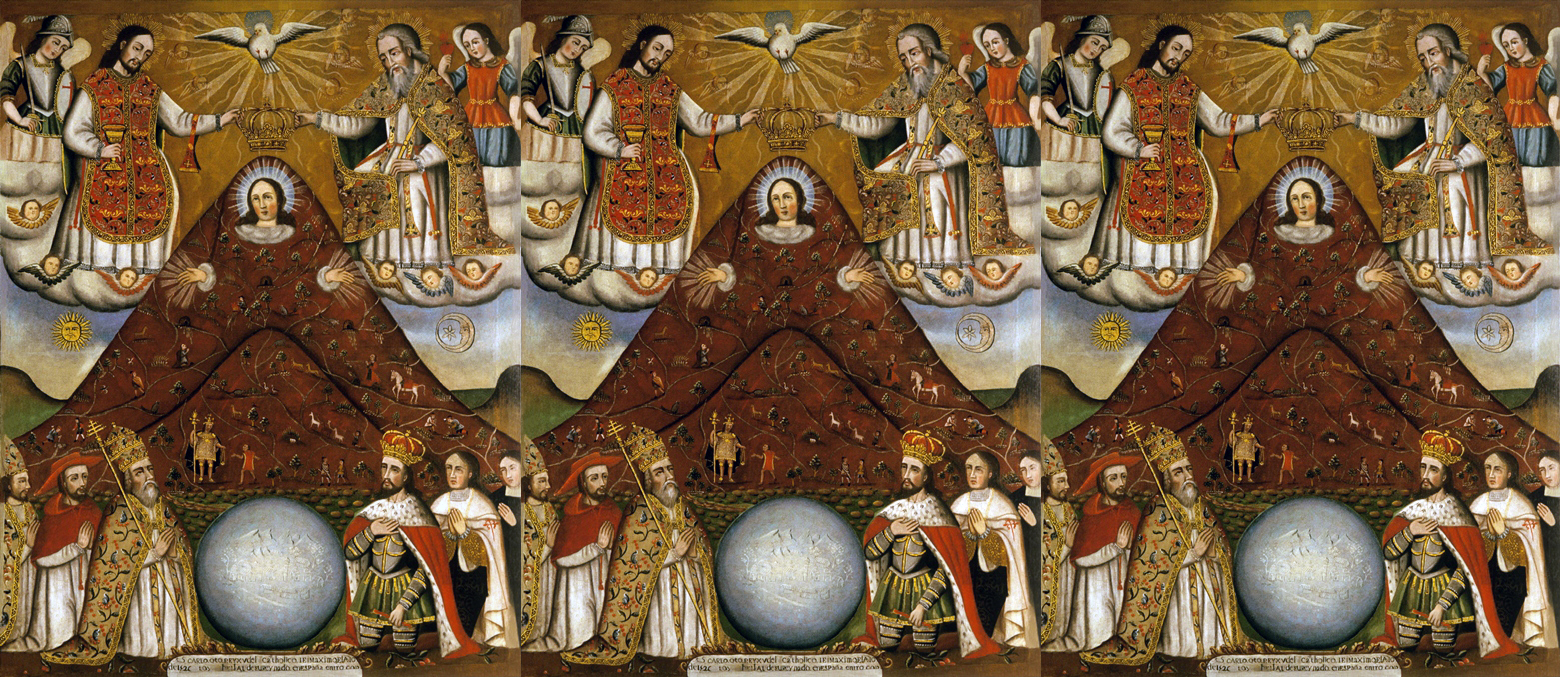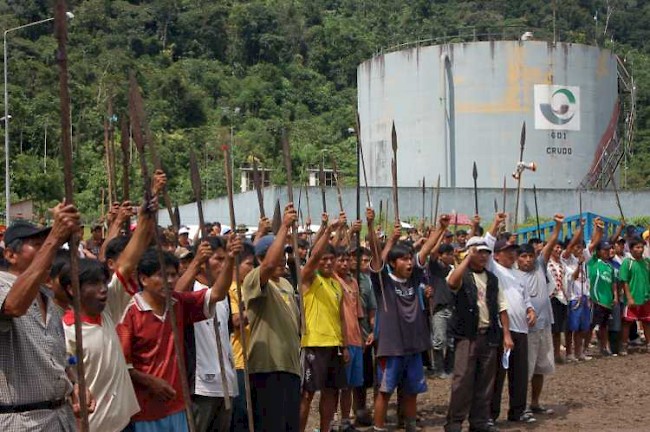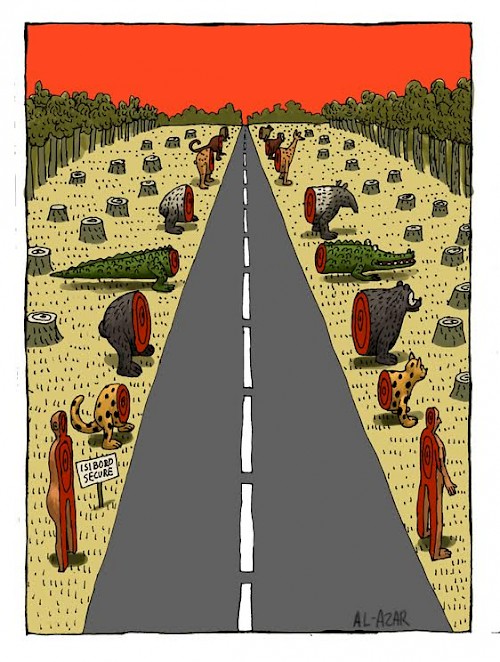— Uncommoning Nature

On June 5, 2009, at dawn, a violent confrontation took place between police forces and a large group of Peruvian citizens declaring themselves as belonging to the Awajun-Wampis indigenous groups. The police’s objective was to break up a blockade at a major highway near the town of Bagua in the Amazonian lowlands of northern Peru. The Awajun-Wampis had taken control of the highway at a place called La Curva del Diablo (Devil’s Curve) as part of a general strike that started on April 9 that same year, organized by several Amazonian indigenous groups. They were protesting a series of legislative decrees conceding their territory to oil exploration without abiding by the Indigenous and Tribal Peoples (ILO) Convention No. 169, which requires that governments consult inhabitants of territories that corporations may approach for exploration and exploitation. Accordingly, the concession was illegal, as the protestors declared. The clash yielded more than thirty deaths between policemen and the Awajun-Wampis, according to the official count. On June 19 that same year, against the will of then president Alan García, the congress canceled the decrees. The local state ordered the arrest of a number of indigenous leaders, among them Santiago Manuin Valera, the prominent Awajun-Wampis leader. They face thirty-three counts of death. During his testimony on April 10, 2014, Manuin said:
The government is taking away our territory, the territory of the Awajun-Wampis people, so that we become dependent on its [form of] development. The government never asked: Do you want to develop? They did not consult us. We responded: “Cancel the legislative decrees that affect our existence as a people.” Instead of listening to our complaint, the government wanted to punish us—other peoples surrendered, we did not. The government ordered our forced eviction.
The event is part of what I am calling the anthropo-not-seen: the world-making process through which heterogeneous worlds that do not make themselves through the division between humans and nonhumans—nor do they necessarily conceive the different entities in their assemblages through such a division—are both obliged into that distinction and exceed it. Dating from the fifteenth century in what became the Americas, the anthropo-not-seen was, and continues to be, the process of destruction of these worlds and the impossibility of such destruction. It might very well represent the first historical apocalypse: the will to end many worlds that produced the one-world world and its excesses.1 I will use examples of events and conditions of life in Latin America because it is the space that I am familiar with. However, anthropo-not-seen is an event throughout the planet.

Scholars have discussed the Anthropocene as a transformation of humanity into a geological force capable of affecting, and possibly destroying, what we currently know as the world. The anthropo-not-seen has been sustained since its early beginnings by a human moral force—and the unseen part of its destructive dynamic can be found in how this force has been considered constructive. Counterintuitively, this particle of the word (the not-seen) does not refer only to the anthropos—“the one who looks up from the Earth”—and is capable of destroying what refuses to be made in its image.2Karolina Sobecka, “Last Clouds,” in Art in the Anthropocene, ed. Heather Davis and Etienne Turpin (London: Open Humanities Press, 2015), 215 → Exceeding this destruction, the anthropo-not-seen includes more-than-human assemblages, both in the usual sense (i.e., that they may include humans and nonhumans), and in the sense that these categories (human and nonhuman, and therefore species) are also inadequate to grasp such compositions, which as said above, may not become through these categories.3Dorion Sagan, “The Human is More than Human: Interspecies Communities and the New ‘Facts of Life,’” Cultural Anthropology Online, April 24, 2011 → The assemblages of the anthropo-not-seen may be translated as “articulated collectives” of nature and humans, yet may also express conditions of “no nature, no culture.”4Donna Haraway, “The Promise of Monsters: A Regenerative Politics for Inappropriate/d Others,” in Cultural Studies, ed. Lawrence Grossberg, Cary Nelson, and Paula A. Treichler (New York: Routledge, 1992), 314; Marilyn Strathern and Carol MacCormack, ed., Nature, Culture, and Gender (Cambridge: Cambridge University Press, 1980).
The antropo-not-seen was, and continues to be, a war waged against world-making practices that ignore the separation of entities into nature and culture—and the resistance to that war. The antagonism was clear in the seventeenth century: Christian clerics walked the Andes from Colombia to Argentina and Chile “extirpating idolatries” that the friars conceived as “devil-induced worship.” Extirpation required dividing entities into God-created nature (mountains, rivers, forests) and humans, and saving the soul of the latter. The invention of modern politics secularized the antagonism: the war against recalcitrance to distinguish nature from humanity silently continued in the name of progress and against backwardness, the evil that replaced the devil. Incipient humans became the object of benevolent and inevitable inclusion, enemies that did not even count as such. Until recently, that is.
The War is Not Silent Anymore (But it Continues Undeclared)
The expansion of markets for minerals, oil, and energy, as well as for new technologies that allow for their quick and profitable extraction, stimulate what appears to be an unprecedentedly unstoppable—and mighty—corporate removal of resources in places formerly marginal to capital investment. The construction of infrastructure (necessary to send the resources to market) sponsored by central financial institutions like the IMF, the World Bank, and new regional financial entities like the Latin American Development Bank has made even the most remote territories the object of financial investment. The reach of the current destruction of indigenous worlds is historically unparalleled; the anthropo-not-seen (the destruction of worlds and resistance to it) has acquired a scope and speed that early extirpators of idolatries and nineteenth-century explorers (turned rubber and sugar plantation investors) would envy.
Overlapping with environmental devastation and converging on Anthropocenic forces at the planetary level, the transformation of territories into grounds for investment has met with strong local opposition and forceful disagreement—transforming the silent war into a relentless demand for politics that reveals, to paraphrase and tweak Rancière, the presence of many worlds being forced into one. Digging a mountain to open a mine, drilling into the subsoil to find oil, damming all possible rivers, and razing trees to build transoceanic roads and railroads translates, at the very least, into the destruction of networks of emplacement that make local life possible. Among other demands, local worlds—labeled indigenous or not—defy the monopoly of modern practices in making, inhabiting, and defining nature. With their hopes for economic growth at stake and the sovereignty over their territorial rule threatened, national states waver between rejecting the proposal for politics that local worlds extend and ending the silent war to wage it overtly—always in the name of progress. The confrontation in 2009 in La Curva del Diablo is emblematic of the war becoming public: those who oppose the transformation of universal nature into resources and oppose the possibility of the common good as the mission of the nation-state are its enemies and deserve prison at the very least.

Conceptualized through the anthropo-not-seen, the war is, however, peculiar. Defending themselves, worlds whose sacrifice progress demands have publicly revealed their practices through television stations and newspapers. Thus, it has come to the attention of the public (and majoritarian derision) that nature—as the alleged grounds for the common good—is not only that. For example, warning about the destruction of its world, the Awajun-Wampis leadership has described their sibling relation to the Amazon rainforest: “The river is our brother, we do not kill our brother by polluting and throwing waste on it”—kinship transforms rivers, plants, and animals into entities that financial capital, infrastructure, and contamination can kill rather than “merely” destroy or deplete. As ubiquitous as the war, these revelations slow down the translation of those entities into universal nature. The one-world world that Christianity and modernity collaboratively built and sustained is perhaps being challenged with an unprecedented degree of publicity for the first time since its inauguration five hundred years ago. This possibility needs to be cared for.
Uncommoning Nature: Or, a Commons through Divergence5Divergence is a notion I borrow from Isabelle Stengers. It refers to the constitutive difference that makes practices what they are and as they connect across difference, even ontological difference. See Isabelle Stengers and Philippe Pignarre, Capitalist Sorcery: Breaking the Spell, trans. Andrew Goffey (London: Palgrave MacMillan, 2011).
Analogous to the Awajun-Wampis’s claim of kinship with the forest, in a dispute about petroleum extraction in a site called Vaca Muerta (Argentina) a Mapuche group declared “Our territories are not ‘resources’ but lives that make the Ixofijmogen of which we are part, not its owners.”6“Vaca Muerta, Una Situación Urgente Que No da Para Más,” Argenpress, October 7, 2014 →; and “Un Viaje a las Entrañas de Vaca Muerta, el Futuro Energético del Pais,” Misiones Online, March 7, 2015 →. “Ixofijmogen” is the Mapuce concept of “biodiversity.” In contrast, developers from Neuquén defined Vaca Muerta as one of the states included in the alleged hydrocarbons deposit: “Vaca Muerta is an immense páramo [a barren cold plateau]. A desert that extends beyond what the eyes can see … It is a hostile territory that shelters enough energy to make Argentinian self-sufficient and even export gas and oil to the world.” The stark contrast suggests that the dispute about the extraction of petroleum is also a dispute about the partition of the sensible into universal nature and culturally diversified humanity, to paraphrase Rancière and Latour, respectively.7Jacques Rancière, “Ten Theses on Politics,” Theory and Event 5:3 (2001).
Emphasizing the inherent relationality between local entities (humans and other-than-human beings), the dispute questions the universality of the partition: what is enacted as humans and nature is not only enacted as such.8I have explained this in other works. Dwelling across more than one and less than many worlds, practices may enact not-only entities: other-than-human beings emerge not only as such, but also as nature and humans. See Marisol de la Cadena, “Indigenous Cosmopolitics in the Andes,” Cultural Anthropology 25:2 (May 2010); and Marisol de la Cadena, Earth Beings (Durham, NC: Duke University Press, 2015). John Law calls this the capacity for both/and (rather than either/or). The interruption of the universal partition is a political and conceptual worlding event; what emerges through it is not a “mix” of nature and human. Being composed as humans with nature—if we maintain these categories of being—makes each more. Entities emerge as materially specific to (and with!) the relation that inherently connects them. An example located in the Andes of Cuzco: the materiality that relates modern humans and mountains is different from that which makes runakuna (the local Quechua word for people) with Earth-beings—entities that are also mountains.9Marisol de la Cadena, “Runa: Human But Not Only,” Journal of Ethnographic Theory 4:2 (Fall 2014) →
The processes questioning the universality of partitioning the sensible into universal nature and humans, of course, do not require runakuna with Earth-beings. Here is another example: in the northern Andes of Peru, a mining corporation plans to dry out several lagoons to extract copper and gold from some, and to throw mineral waste into others. In exchange, reservoirs with water capacity several times that of the lagoons would be built. Opposing the plan, environmentalists argue that the reservoirs will destroy the ecosystem of the lagoons, a landscape made of agricultural land, high-altitude wetlands, cattle, humans, trees, crops, creeks, and springs. The local population adds that the lagoons are their life: their plants, animals, soils, trees, families are with that specific water which cannot be translated into water from reservoirs, not even if more water is provided, as the mining corporation promises to do. It would not be the same water, which they defend as “guardians of the lagoons.” People have died in this making-public of another instance of the war against those who oppose the translation of nature into resources. Yet the guardians of the lagoons have never said that the water is a being—it is local water, and as such, nature, yet untranslatable to H2O.
An iconic “guardian of the lagoons” is a peasant woman whose property the corporate mining project wants to buy to fully legalize its access to the territories it plans to excavate. The woman refuses to sell—even for what is most likely an amount of money she will not see in her lifetime. Countless times, the national police force has attacked her, her family, even her animals—as I was writing this piece, the police destroyed the woman’s crops. The property has been under siege for more than three years now. “I fight to protect the lagoon” has been one of her responses. And asserting attachment to place, she adds: “I am not going to stop; they will disappear me. But I will die with the land.” Like Bartleby, she “would prefer not to” sell; yet she is not politically a-grammatical, at least not in the usual sense.10Gilles Deleuze, “Bartleby, ou la Formule,” in Critique et Clinique (Paris: Editions de Minuit, 1993), 89–114.

Within the grammar that separates humans and universal nature, this woman can be interpreted as defending the ecosystem: an environmentalist, and thus an enemy (and a fool), or an ally (and a hero), depending on who speaks. In both cases she is a subject in relation to an object. However, the “refusal to sell” may express a different relation: one from which woman-land-lagoon (or plants-rocks-soils-animals-lagoons-humans-creeks—canals!!!) emerge inherently together: an ecological entanglement needy of each other in such a way that pulling them apart would transform them into something else.11Another example of a similar relational materiality: peasants in the Isthmus of Juchitán (Oaxaca, Mexico) have rejected the installation of windmills which would transform the relationship between air, birds, ocean water, fish, and people. See Cymene Howe, “Anthropocenic Ecoauthority: The Winds of Oaxaca,” Anthropological Quarterly 87:2 (Spring 2014). Refusing to sell may also refuse the transformation of the entities just mentioned into units of nature or the environment, for they are part of each other. The woman’s refusal would thus enact locally an ecologized nature of interdependent entities that simultaneously coincides, differs, and even exceeds—also because it includes humans—the object that the state, the mining corporation, and environmentalists seek to translate into resources, whether for exploitation or to be defended. Thus seen, she is a-grammatical to the subject and object relation—or, she is not only an environmentalist.
Occupying the same space (that “cannot be mapped in terms of a single set of three-dimensional coordinates”), this complex heterogeneous form (universal nature, the environment, and what I am calling ecologized nature—or nature recalcitrant to universality) allows for alliances and provokes antagonisms.12Annemarie Mol and John Law, “Complexities: An Introduction,” Complexities: Social Studies of Knowledge Practices, ed. Annemarie Mol and John Law (Durham, NC: Duke University Press, 2002). Confronted with the mining company’s proposal to desiccate the lagoons, its local guardians and environmentalists have joined forces against the mining corporation. Yet their shared interest—to defend nature, or the environment—is not only the same interest: ecologized nature and universal nature exceed each other; their agreement is also underpinned by uncommonalities. This condition shapes a possibility for an alternative alliance, one that, along with coincidences, may include the parties’ constitutive divergence—even if this opens up discussion of the partition of the sensible and introduces the possibility of ontological disagreement into the alliance. An oxymoronic condition, this alliance would also house hope for a commons that does not require the division between universal nature and diversified humans: a commons constantly emerging from the uncommons as grounds for political negotiation of what the interest in common—and thus the commons—would be.
Instead of the expression of shared relations, and stewardship of nature, this commons would be the expression of a worlding of many worlds ecologically related across their constitutive divergence. As a practice of life that takes care of interests in common, yet not the same interest, the alliance between environmentalists and local guardians (of lagoons, rivers, forests) could impinge upon the required distribution of the sensible into universal nature and locally differentiated humans, thus disrupting the agreement that made the anthropo-not-seen and questioning the legitimacy of its war against those who question that distribution. The alliance would also queer the requirement of politics for sameness and provoke ontological disagreement among those who share sameness—inaugurating an altogether different practice of politics: one across divergence.
×


